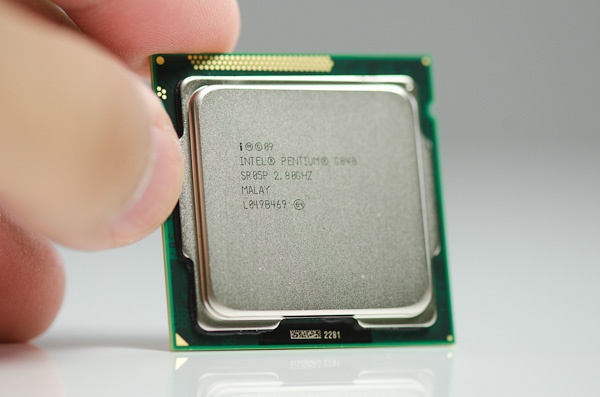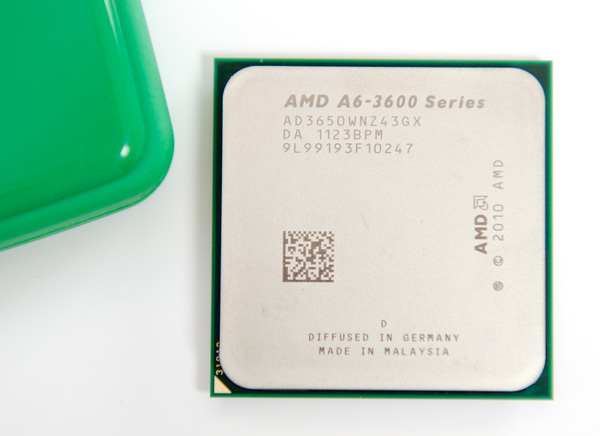The Sandy Bridge Pentium Review: G850, G840, G620 & G620T Tested
by Anand Lal Shimpi on August 23, 2011 12:11 AM ESTFinal Words
Despite boasting Intel's latest Sandy Bridge microarchitecture, the conclusions here are pretty much unchanged from the past. Intel maintains an advantage when it goes up against an AMD chip with the same number of cores, almost regardless of clock speed. In the case of the Pentium G620, even an Athlon II X2 265 with a 27% clock speed advantage can't outperform the Sandy Bridge based CPU. If you're choosing between chips with the same number of cores at the same price, Intel wins.
The decision tilts in AMD's favor if you start comparing to the Athlon II X3. In heavily threaded workloads, the Athlon II X3's third core helps put it ahead of the entire SNB Pentium lineup. If you're building a machine to do offline 3D rendering, multithreaded compiling or video transcoding then AMD continues to deliver the best performance per dollar. It's in the lighter, less threaded workloads that the Pentium pulls ahead. If you're building more of a general use system (email, web browsing, typical office applications and even discrete GPU gaming), the Pentium will likely deliver better performance thanks to its ILP advantages. What AMD has offered these past couple of years is an affordable way to get great multithreaded performance for those applications that need it.
Unfortunately the entire Sandy Bridge Pentium lineup is clock locked. Without turbo modes there's no support for overclocking at all. While these new Pentiums would have normally been great for enthusiasts looking to overclock, Intel has ensured that anyone looking to get more performance for free at the low end will have to shop AMD. Unfortunately Intel's advantage in single/lightly threaded performance is big enough that a clock speed advantage alone is generally not enough to make up for it (see G620 vs. Athlon II X2 265 comparison). It's sad that it has come to this. I was hoping we'd see more K-series SKUs at the low end but it seems like those will only be for the enthusiasts at the high end.
The Pentium's on-die GPU isn't particularly impressive. It's the HD Graphics 2000 from the rest of the Sandy Bridge lineup without Quick Sync or any of the extra video features. I am particularly sad that Quick Sync is missing as it would've made these Pentiums extremely attractive for users that do a lot of video transcoding. Thankfully video decode acceleration and HD audio bitstreaming support remain, so if you're looking to build a cheap Sandy Bridge based HTPC and don't care about the frills these chips will work just fine.
However, if you're building a system to do any sort of 3D gaming you're much better off either springing for a cheap discrete card or looking at AMD's A6-3650 if you want to stay integrated. Although you can play older titles at low resolution on the Pentium's on-board GPU, you'll have a much better experience with a discrete GPU or with the A6.
It all boils down to this. If you want a good, cheap, general purpose PC then the Pentium G620 seems competent and cheap. You can consider the G840 if you want a bit more performance. If you do a lot of threaded work (e.g. offline 3D rendering) the next step up is the Athlon II X3 455. If you do any amount of consumer level video transcoding using apps that are Quick Sync enabled, opt for the Core i3 2100 instead. If gaming is important to you then either buy a discrete GPU or look to AMD's Llano.
As far as AMD's A6 vs. A8 goes, the A8-3850 only commands a $20 price premium over the A6-3650. That $20 gives you another 8 - 10% on the CPU side and around 20% on the GPU. In my opinion, if you're considering a Llano system - spring for the A8.












110 Comments
View All Comments
iwod - Tuesday, August 23, 2011 - link
The sad thing is AMD is still using a CPU core then is two generation behind Intel. We will have to wait for Bulldozer + updated GPU for a decent low end CPU.However by the time Intel would have either Ivy or Haswell ready.
AMD you need to work harder.
CeriseCogburn - Monday, June 25, 2012 - link
iwod, you may have waited, and achieved: massive, epic failure, amd style...Since amd still has to be sold with endless lies, everyone knows the answer that few are willing to admit.
I congratule on amd lying about bulldozer transistor count, fanning their fanboys to the outer limits of worshipful surrender.
Targon - Tuesday, August 23, 2011 - link
Now that Firefox and IE9 support GPU acceleration, adding these to the CPU benchmarks SHOULD be seen as fairly important when talking about low to mid range processors/GPUs. I suspect that if running Firefox 6 with Flash(due to banner advertisements and such), you might see some interesting results on a per-core basis between the AMD A6 and Intel Pentium chips reviewed here.fuzzymath10 - Tuesday, August 23, 2011 - link
I'm pretty sure you need only DX10 for that. My laptop's x3100 IGP from 2008 supports h/w rendering because the driver is DX10. Flash video decoding is more restricted, but it's possible the new Intel IGPs will work since they have DXVA decoding of h.264.Targon - Tuesday, August 23, 2011 - link
The GPU acceleration obviously will be better with a faster GPU in browsers and Flash, and that helps level the playing field in this case. I would like to see how much it levels the playing field.JarredWalton - Tuesday, August 23, 2011 - link
If you have a good benchmark for measuring performance in IE9 and FF6, I'd love to hear it. Sure, I can open up a Flash video, but on any modern GPU (including Arrandale's IGP), it's not a problem. Even GMA 4500MHD could handle Flash video content with the latest drivers (helped by the CPU of course).The problem is coming up with a meaningful benchmark with browsers. Are we supposed to look at CPU usage while watching a video, or power usage? Do we go to some weird web page benchmark that stresses the GPU accelerated portions of the browser, even though 99% of web sites look like our site and don't benefit? I've got from Firefox 1 through 6, most versions of Chrome, every major Internet Explorer release, and I've even dabbled with Safari (sucks on Windows!) and Opera. Unless you're playing Flash games, I haven't ever felt that any of the browsers was "too slow"; mostly I stuck with FF for the extensions, but I've moved to Chrome now. Both still run fine whether I'm on IGP or dGPU.
I guess my point is, sure, you can create a browser test that stresses GPUs/CPUs to the point where it's a benchmark, but is it actually useful data? If a web site is putting a 100% load on your CPU, GPU, or both, it's a poorly designed site for normal use.
knedle - Tuesday, August 23, 2011 - link
I have bought few months ago 620T, compared to AMD I was previously using, power consumption is much smaller, same goes for noise, I can't hear it with stock cooling.My whole computer with high quality PSU, 3 HHDs (all power saving), a DVD and some basic ASUS motherboard takes only 60W in stress, and for things I do with this computer, it's far more superior than AMD.
I should mention, that I use my computer as server for backups of my customers servers, so I need high IO rate without any bottlenecks, and AMD always gave me problems with that. For example, AMD had problems while I wanted to watch a movie, while 2 servers were sendbing backups to my computer and saving it to LVM on software RAID array.
koan00 - Tuesday, August 23, 2011 - link
On page 3, the link to "Bench" is broken in the second sentenceAlso, the hardware setup lists a Corsair drive for the Hard Disk, but then 2 paragraphs down references the Intel XM25-M ?
Ryan Smith - Tuesday, August 23, 2011 - link
The Bench link looks fine here. What are you seeing?koan00 - Tuesday, August 23, 2011 - link
It initially linked to "http://www.anandtech.com/show/4524/the-sandy-bridg... but it appears to be correct now. Thanks.